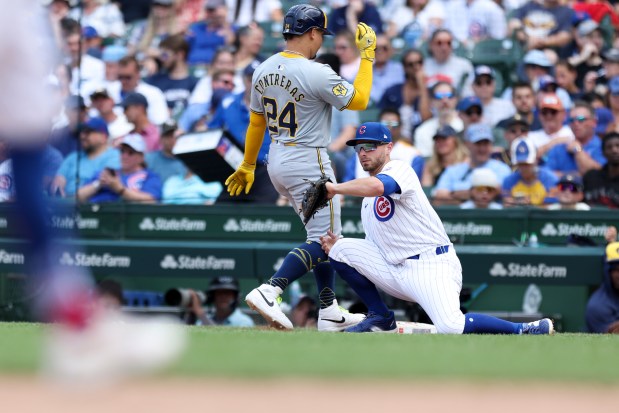Before July ends, the Chicago Cubs already have wrapped up their season series against the Milwaukee Brewers, and despite their offseason moves, a disparity between the two franchises remains.
An unbalanced schedule set up the Cubs to complete their slate against the Brewers this week, and with Milwaukee taking the series with a 3-2 victory Wednesday, the Cubs went 5-8 against their rivals to the north. The Brewers left Wrigley Field with a six-game lead over the St. Louis Cardinals in the National League Central while the Cubs are last in the division, 11 games back.
As the Cubs try to regroup on Thursday’s off day ahead of the final stretch before the trade deadline, here are three takeaways from an underwhelming performance versus the Brewers.
1. Offensive futility remains a staple of struggles
The root of the Cubs’ problems has been frustratingly apparent to the organization, yet they continuously struggle to score runs.
The Cubs’ nine runs in their last six games are the second fewest in the majors since the All-Star break, ahead of only the White Sox (eight). They wasted strong performances by Jameson Taillon (one earned run in 7 1/3 innings) and Justin Steele (two earned runs in 5 1/3) in back-to-back games.
“We just didn’t do enough offensively,” manager Craig Counsell said Wednesday. “There wasn’t any traffic, wasn’t any at-bats or innings to put pressure on them. It was just a light offensive day.”
Both of the Cubs’ losses to the Brewers came in one-run games, dropping them to 15-22 in such contests. The Cubs haven’t played well enough this season in the tightest moments, too often frustratingly sloppy for a veteran team that should not be making those kinds of costly mistakes. Most often the burden has fallen on the offense for falling short, a lineup that was supposed to feature consistency from top to bottom while lacking a true superstar hitter. The formula has not paid off and will require further scrutiny by the front office in assessing how to build the roster.
2. Poor homestand sets trade-deadline course
The Cubs finally had built some momentum with a 5-2 stretch in Baltimore and St. Louis entering the All-Star break last week to at least give them a chance to finally get on the type of sustainable roll they have been seeking since April.
Instead, the Cubs went 2-4 at home against the Arizona Diamondbacks and Brewers to put them six games under .500 with four games left before Tuesday’s trade deadline. President of baseball operations Jed Hoyer had indicated Monday that, barring a drastic turnaround in the week leading up to the break, the Cubs would not look to acquire rental players who would solely help the 2024 team.
That leaves the Cubs open to move players who can help a playoff contender this season or don’t fit the roster in 2025. Their bullpen remains the most appealing area to trade players with pitchers typically being the most coveted this time of year. It’s an ugly position to be in for the Cubs, given the players they have acquired the last two offseasons. Hoyer again is tasked with making the right read on the market and finding a way to make sure the talent they bring in gets them to the postseason next year.
3. Michael Busch’s defensive work shines
One of the few bright spots among the Cubs’ position players this year is rookie first baseman Michael Busch.
After some early struggles with his footwork around the base and testing the limits of his fielding range, Busch’s glove work at first has been a regular highlight for the Cubs. Busch’s 6 Defensive Runs Saved (DRS) are second most among big-league first basemen in his first full season at the position.
“With anything reps and time obviously makes it a little more comfortable,” Busch said. “Not saying that I wasn’t comfortable early in the year, I think it’s just gotten to the point where I’m pretty consistent with it and I feel pretty good.”
His performance hasn’t gone unnoticed by his teammates, who have watched the work he has put in on a near-daily basis since the beginning of spring training. For all the questions surrounding the Cubs and who on the roster should be part of a core moving forward, Busch’s stellar all-around season has been an important development.
“He’s been great all year,” Ian Happ said. “Making good decisions, walk rate is pretty impressive to get that deep into counts, just the quality of at-bat every single day. Defensive side’s been super impressive, that’s the side he’s worked so hard on. … He just continues to get better over there.”



